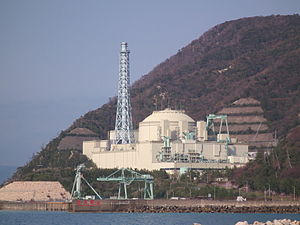
Back Kernkraftwerk Monju German نیروگاه هستهای موانجو Persian Centrale nucleare di Monju Italian もんじゅ Japanese 몬주 (원자로) Korean Kernenergiecentrale Monju Dutch Monju kjernekraftverk NB Elektrownia jądrowa Monju Polish АЭС Мондзю Russian Monju kärnkraftverk Swedish
| Monju Nuclear Power Plant | |
|---|---|
 Monju Nuclear Power Plant | |
 | |
| Official name |
|
| Country | Japan |
| Location | Tsuruga, Fukui Prefecture |
| Coordinates | 35°44′25″N 135°59′17″E / 35.74028°N 135.98806°E |
| Status | Being decommissioned |
| Construction began | May 10, 1986 |
| Commission date | August 29, 1995 May 6, 2010 (reactivated) |
| Decommission date | December 8, 1995 (suspended for 15 years) |
| Operator(s) | Japan Atomic Energy Agency |
| Nuclear power station | |
| Reactor type | FBR |
| Power generation | |
| Units operational | 1 × 280 MW |
| Nameplate capacity | 280 MW |
| External links | |
| Website | www |
| Commons | Related media on Commons |
Monju (もんじゅ) was a Japanese sodium-cooled fast reactor, located near the Tsuruga Nuclear Power Plant, Fukui Prefecture. Its name is a reference to Manjusri. Construction started in 1986 and the reactor achieved criticality for the first time in April 1994. The reactor has been inoperative for most of the time since it was originally built. It was last operated in 2010[1] and is now closed.
Monju was a sodium cooled, MOX-fueled, loop-type reactor with three primary coolant loops, designed to produce 280 MWe from 714 MWt. It had a breeding ratio of approximately 1.2.[2] The plant is located on a site that spans 1.08 km2 (267 acres), the buildings occupy 28,678 m2 (7 acres), and it has 104,680 m2 of floor space.
An accident in December 1995, in which a sodium leak caused a major fire, forced a shutdown. A subsequent scandal involving a cover-up of the scope of the accident delayed its restart until May 6, 2010, with renewed criticality reached on May 8, 2010.[3] In August 2010 another accident, involving dropped machinery, shut down the reactor again. As of June 2011, the reactor had only generated electricity for one hour since its first testing two decades prior.[4] As of the end of 2010, total funds spent on the reactor amounted to ¥1.08 trillion. An estimated ¥160–170 billion would be needed to continue to operate the reactor for another 10 years.[5] As of 2014, the plant had cost ¥1 trillion ($9.8 billion).[6]
A final decision on the project (e.g. to decommission or extend funding) was due by end 2016,[7] and a decision to close the facility was made in December 2016.[8][9] In December 2017 the Japan Atomic Energy Agency applied for approval of its decommissioning plan by the Nuclear Regulation Authority. Decommissioning and dismantling are planned to be completed by 2047 and is expected to cost ¥375 billion.[10]
- ^ "Time to shutter Monju". The Japan Times. 25 February 2014. Retrieved 4 May 2015.
- ^ "Basic specifications". Archived from the original on 2013-01-23. Retrieved 2013-05-16.
- ^ Tsutomu Yanagisawa (4 March 2011). "Monju, modified". Nuclear Engineering International. Archived from the original on 30 January 2013. Retrieved 28 January 2012.
- ^ Tabuchi, Hiroki (June 17, 2011). "Japan Strains to Fix a Reactor Damaged Before Quake". The New York Times.
- ^ Kyodo News, "Monju costs far surpass usual nukes", Japan Times, 4 July 2012, p. 3
- ^ Cite error: The named reference
afp-20140207was invoked but never defined (see the help page). - ^ Dennis Normile (21 September 2016). "Japan likely to scrap experimental nuclear power reactor". Science. Retrieved 3 December 2016.
- ^ "Japan cancels failed $9bn Monju nuclear reactor". BBC. 21 December 2016. Retrieved 23 December 2016.
- ^ "Japanese government says Monju will be scrapped". World Nuclear News. 22 December 2016. Retrieved 23 December 2016.
- ^ "Japan closes Ohi 1&2 and Monju". Nuclear Engineering International. 29 December 2017. Retrieved 29 December 2017.
© MMXXIII Rich X Search. We shall prevail. All rights reserved. Rich X Search